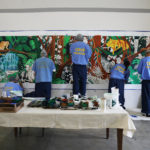by Jan Roberts
I love the beauty and the power of the arts to bring my emotions to the fore. I also am loving the increasing engagement and visibility of the arts in activism that promote the wellbeing of humanity, communities and the planet.
 Despite their valid concerns of turning off potential audiences or donors, museums have been putting their toes in the waters being stirred by pressing societal problems. They are being aided by partnerships with artist groups and art organizations that use art to inspire and engage viewers emotionally and intellectually to be agents of change. The Museum of Fine arts in Boston collaborated with the Guerrilla Girls, a feminist activist artists group on their exhibition “Political Intent”. It is a commentary through posters on racial and gender discrimination in the arts and popular culture. Arts for Change based in Oakland, California partners with museums nationally and globally to host exhibitions related to topics from human trafficking to climate change disasters.
Despite their valid concerns of turning off potential audiences or donors, museums have been putting their toes in the waters being stirred by pressing societal problems. They are being aided by partnerships with artist groups and art organizations that use art to inspire and engage viewers emotionally and intellectually to be agents of change. The Museum of Fine arts in Boston collaborated with the Guerrilla Girls, a feminist activist artists group on their exhibition “Political Intent”. It is a commentary through posters on racial and gender discrimination in the arts and popular culture. Arts for Change based in Oakland, California partners with museums nationally and globally to host exhibitions related to topics from human trafficking to climate change disasters.
Even Norman Rockwell is getting into the picture with an international tour in 2018 of his paintings. The museum that bears his name in Massachusetts is sending on the road the “Four Freedoms”–freedom of speech and worship, freedom from want and fear and others including some addressing human rights issues. Laurie Norton Moffatt, director of the museum, believes the exhibition along with symposiums and educational programs will show how Rockwell’s work “helped make the case for universal human rights.”
Barnes Foundation in Philadelphia is taking or more accurately making art out of what is happening in the streets.. Their exhibit “Person of the Crowd: Contemporary Art of Flânerie” through May 22 is showcasing how more than 50 international artists engaged with communities.. This wide ranging show touches on gentrification, gender politics, globalization, racism and homelessness. Flânerie stems from the French word for « a person who walks in the city to experience it ». New York based artist Man Bartlett is working alongside Philadelphia-area teenagers to create videos documenting their experiences, inspired by visits to the city’s public spaces. View here. He is also documenting street performances and inviting people to share their opinions of city life via social media.

Prisons have over the years hosted programs to engage prisoners with art ranging from putting on Shakespeare plays to using paint, pen, and/or music to capture their own life stories and experiences. California, big surprise, is heading up the largest initiative to date by bringing the arts to all 35 of its state prisons for adults. The classes include Native American beadwork, mural painting, improvisational theater, graphic novels and songwriting. This effort flies in the face of the cutting of federal arts agencies. The state has allocated $6 million annually for the Arts in Corrections program with $8 million next year. The Corrections program in partnership with the California Arts Council hires respected art experts to teach the classes.
Mary Butler, president of the Chief Probation Officers of California says that although arts classes alone do not change criminal thinking or behavior, they can change behavior within a prison. Tom Lackey, a republican state assemblyman, balked at first at the funding of the initiative. He now admits that he wasn’t prepared for the impact. “I could tell it was building morale and self-respect among inmates, which is hard to do. How do you measure the value of a person in dollars? This is an investment that yields a return.”
“The country is so wounded, bleeding, and hurt right now. The country needs to be healed—it’s not going to be healed from the top, politically. How are we going to heal? Art is the healing force.” ~ Robert Redford, National Arts Policy Roundtable 2012
